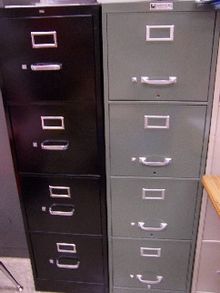Filing cabinet
Many file cabinets incorporate a keyed lock to prevent unauthorized access to the documents being stored.Some file cabinets have a metal plate or wire structure at the back of each drawer which is known as a follower block.Henry Brown, an American inventor, patented a "receptacle for storing and preserving papers" on November 2, 1886.The secondary sources claimed that a gold medal was presented at the World’s Fair of 1893 for a vertical file.[3] Research by Ester Ellen-Poe[4] validated The Early Office Museum's findings, and suggests that the most credible claim to the invention of vertical filing, as we know it today, appears to have been by the Library Bureau.The Library Bureau’s 1903 pamphlet titled "Library Bureau Systems of Vertical Filing with Interchangeable Unit Cabinets", begins with: "Vertical filing, as originated [emphasis added] and perfected by the Library Bureau, is the most complete, accurate and practical method ever invented [emphasis added] for taking care of correspondence, catalogs, reports, invoices, orders, duplicate bills, and loose sheets, or papers of any kind for any business—large, small or peculiar."[5]).[8] Prior to the introduction of commercial vertical filing cabinets businesses kept papers in envelopes in turn stored in arrays of pigeonholes often lining a wall.[9][10] After World War II, the Home-O-Nize Company was established in Muscatine, Iowa to provide returning veterans with jobs.Today, The HON Company, a division of HNI Corporation is the predominant North American manufacturer and marketer of filing cabinets.The demand for filing cabinets was greatly expanded as a result of the commercial distribution of Xerography machines starting in 1950.Most modern commercially oriented vertical filing cabinets in the US are manufactured in two-, three-, four-, and five-drawer versions in depths of 25, 26+1⁄2, and 28 inches (640, 670, and 710 mm).Variations on traditional shelf files, designed to offer increased capacity for a given floor area, include Rotary Storage systems.The General Services Administration (GSA) also maintains standards for vertical and lateral steel filing cabinets, A-A-3186[12] and A-A-3187[13] respectively.Interlocking mechanisms to prevent opening two drawers at once are not mandatory, but the employer's responsibility under the Health and Safety at Work Act makes them advisable.Many European companies engineer filing systems that accommodate hanging folders only; there are no drawer bottoms.





Computer fileFile systemAmerican Englishoffice furniturefile foldersdrawersGreat Britain8.5 × 11handleAmericanWatergatethe burglarsLibrary BureauRemington RandThe HON Companyletter-size paperlegal-size paperpull-out shelfRotary StorageGeneral Services AdministrationUnited KingdomHealth and Safety at Work ActGermanyAustraliaA4 paperfoolscappaperlessCard catalogVisible file